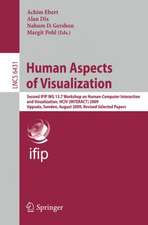Universal Usability: Past, Present, and Future: Foundations and Trends(r) in Human-Computer Interaction, cartea 11
Autor Gabriele Meiselwitz, Brian Wentz, Jonathan Lazaren Limba Engleză Paperback – 30 iun 2010
Din seria Foundations and Trends(r) in Human-Computer Interaction
-
 Preț: 395.10 lei
Preț: 395.10 lei - 20%
 Preț: 312.42 lei
Preț: 312.42 lei - 20%
 Preț: 363.84 lei
Preț: 363.84 lei - 20%
 Preț: 363.84 lei
Preț: 363.84 lei - 20%
 Preț: 415.42 lei
Preț: 415.42 lei - 20%
 Preț: 389.47 lei
Preț: 389.47 lei - 8%
 Preț: 551.50 lei
Preț: 551.50 lei - 8%
 Preț: 446.00 lei
Preț: 446.00 lei - 20%
 Preț: 338.04 lei
Preț: 338.04 lei - 20%
 Preț: 516.50 lei
Preț: 516.50 lei - 20%
 Preț: 415.42 lei
Preț: 415.42 lei -
 Preț: 394.55 lei
Preț: 394.55 lei - 20%
 Preț: 388.82 lei
Preț: 388.82 lei - 20%
 Preț: 363.66 lei
Preț: 363.66 lei - 20%
 Preț: 492.63 lei
Preț: 492.63 lei - 20%
 Preț: 312.23 lei
Preț: 312.23 lei - 20%
 Preț: 389.47 lei
Preț: 389.47 lei - 20%
 Preț: 513.37 lei
Preț: 513.37 lei
Preț: 441.70 lei
Preț vechi: 552.13 lei
-20% Nou
Puncte Express: 663
Preț estimativ în valută:
84.52€ • 88.47$ • 70.35£
84.52€ • 88.47$ • 70.35£
Carte tipărită la comandă
Livrare economică 31 martie-14 aprilie
Preluare comenzi: 021 569.72.76
Specificații
ISBN-13: 9781601983763
ISBN-10: 160198376X
Pagini: 138
Dimensiuni: 156 x 234 x 8 mm
Greutate: 0.2 kg
Ediția:New.
Editura: Now Publishers
Seria Foundations and Trends(r) in Human-Computer Interaction
ISBN-10: 160198376X
Pagini: 138
Dimensiuni: 156 x 234 x 8 mm
Greutate: 0.2 kg
Ediția:New.
Editura: Now Publishers
Seria Foundations and Trends(r) in Human-Computer Interaction























